Understanding the Influence of Genre-Specific Music Using Network Analysis and Machine Learning Algorithms
Abstract
:1. Introduction
2. Related Literature
3. Methodology
3.1. Data Sources and Collection
3.2. Network Construction
Creation of the Directed Network
3.3. Fundamental Network Properties
3.4. Empirical Analysis
3.4.1. Musical Influence Patterns
3.4.2. In-Genre and Out-Genre Influence
- Partition of graph G into two subgraphs: for in-genre influence and for out-genre influence.
- Computation of the eigenvector centrality for each node in and .
- Calculation of the average eigenvector centrality for and as and , respectively.
- Normalization of the averages to obtain the weights:
- For each node in the network, the weighted combined influence value (WCI) is calculated aswhere is the in-genre influence count and is the out-genre influence count. These steps were undertaken to ascertain and for eigenvector centrality; analogously, this methodology is employed to determine and with respect to different centrality measures.
3.5. Inverse Rank-Dominant Influence (IRDI) Algorithm
| Algorithm 1: Inverse rank-dominant influence (IRDI). |
|
3.6. Mathematical Formalism and Complexity Analysis of the IRDI Algorithm
- Iterating over each artist n in V:
- Evaluating the influence score for an average of D influencers for each artist n:
- Sorting the list of influence scores for ranking, which introduces a complexity of
3.7. Influence Propagation Analysis in Musical Networks
3.7.1. Independent Cascade (IC) Model for Musical Networks
| Algorithm 2: Independent cascade model for musical networks. |
|
3.7.2. Adaptation to Musical Networks
3.7.3. Comparative Analysis of Seed Sets
3.7.4. Regression Approach
4. Results
4.1. Musical Influence Patterns
4.2. Impact of In-Genre and Out-Genre Influence
4.3. Impact of Musical Characteristics on Influence
4.4. Dominating Influencers
4.5. Propagation Time Analysis
5. Discussion
6. Conclusions
Author Contributions
Funding
Institutional Review Board Statement
Informed Consent Statement
Data Availability Statement
Acknowledgments
Conflicts of Interest
Appendix A. Data Variables
References
- Lipe, A.W. Beyond Therapy: Music, Spirituality, and Health in Human Experience: A Review of Literature. J. Music Ther. 2002, 39, 209–240. [Google Scholar] [CrossRef] [PubMed]
- Maryprasith, P. The effects of globalization on the status of music in Thai society. Master’s Thesis, Institute of Education, University of London, London, UK, 2000. [Google Scholar]
- Manolios, S.; Hanjalic, A.; Liem, C.C.S. The influence of personal values on music taste: Towards value-based music recommendations. In Proceedings of the 13th ACM Conference on Recommender Systems, Copenhagen, Denmark, 16–20 September 2019; pp. 501–505. [Google Scholar]
- Welch, G.F.; Biasutti, M.; MacRitchie, J.; McPherson, G.E.; Himonides, E. The impact of music on human development and well-being. Front. Psychol. 2020, 11, 1246. [Google Scholar] [CrossRef] [PubMed]
- Hong, J.; Deng, H.; Yan, Q. Tag-based artist similarity and genre classification. In Proceedings of the 2008 IEEE International Symposium on Knowledge Acquisition and Modeling Workshop, Wuhan, China, 21–22 December 2008; pp. 628–631. [Google Scholar]
- Zhang, X.; Ren, T.; Wang, L.; Xu, H. Music Influence Modeling Based on Directed Network Model. arXiv 2022, arXiv:2204.03588. [Google Scholar]
- Bryan, N.J.; Wang, G. Musical Influence Network Analysis and Rank of Sample-Based Music. In Proceedings of the 12th International Society for Music Information Retrieval Conference (ISMIR 2011), Miami, FL, USA, 24–28 October 2011; pp. 329–334. [Google Scholar]
- Wu, H.; Zhang, C. Influence between Music Based on Big Data Analysis. In Proceedings of the 2021 17th International Conference on Computational Intelligence and Security, CIS 2021, Chengdu, China, 19–22 November 2021; Institute of Electrical and Electronics Engineers Inc.: Piscataway, NJ, USA, 2021; pp. 338–342. [Google Scholar] [CrossRef]
- Park, D.; Park, J. Bipartite network analysis of sample-based music. J. Korean Phys. Soc. 2023, 82, 719–729. [Google Scholar] [CrossRef]
- Mu, W. Influence measurement and similarity research Mathematical model based on data analysis and Smart Computing. In Proceedings of the 2021 3rd International Conference on Artificial Intelligence and Advanced Manufacture, Manchester, UK, 23–25 October 2021; pp. 2315–2320. [Google Scholar]
- Raglio, A.; Imbriani, M.; Imbriani, C.; Baiardi, P.; Manzoni, S.; Gianotti, M.; Castelli, M.; Vanneschi, L.; Vico, F.; Manzoni, L. Machine learning techniques to predict the effectiveness of music therapy: A randomized controlled trial. Comput. Methods Programs Biomed. 2020, 185, 105160. [Google Scholar] [CrossRef] [PubMed]
- Carlson, E.; Saari, P.; Burger, B.; Toiviainen, P. Dance to your own drum: Identification of musical genre and individual dancer from motion capture using machine learning. J. New Music Res. 2020, 49, 162–177. [Google Scholar] [CrossRef]
- Manaktala, A.; Kumar, Y. Measuring fuzzy domination in fuzzy weighted directed social networks. In Proceedings of the International Conference on Computing, Communication & Automation, Greater Noida, India, 5–16 May 2015; pp. 237–241. [Google Scholar]
- Rui, X.; Meng, F.; Wang, Z.; Yuan, G. A reversed node ranking approach for influence maximization in social networks. Appl. Intell. 2019, 49, 2684–2698. [Google Scholar] [CrossRef]
- Engsig, M.; Tejedor, A.; Moreno, Y.; Foufoula-Georgiou, E.; Kasmi, C. DomiRank Centrality: Revealing Structural Fragility of Complex Networks via Node Dominance. 2023. Available online: https://api.semanticscholar.org/CorpusID:258715008 (accessed on 20 August 2023).
- Mandyam Kannappan, S.; Sridhar, U. A Flow-Based Node Dominance Centrality Measure for Complex Networks. SN Comput. Sci. 2022, 3, 379. Available online: https://api.semanticscholar.org/CorpusID:250595899 (accessed on 19 July 2023). [CrossRef]
- Kempe, D.; Kleinberg, J.; Tardos, É. Maximizing the Spread of Influence through a Social Network. 2003. Available online: https://api.semanticscholar.org/CorpusID:7214363 (accessed on 18 August 2023).
- Ding, J.; Sun, W.; Wu, J.; Guo, Y. Influence maximization based on the realistic independent cascade model. Knowl. Based Syst. 2020, 191, 105265. Available online: https://api.semanticscholar.org/CorpusID:211830346 (accessed on 12 July 2023). [CrossRef]
- Feng, S.; Chen, W. Causal Inference for Influence Propagation—Identifiability of the Independent Cascade Model. arXiv 2021, arXiv:2107.04224. Available online: https://api.semanticscholar.org/CorpusID:235790641 (accessed on 20 July 2023).
- Wang, B.; Ma, L.; He, Q. IDPSO for Influence Maximization under Independent Cascade Model. In Proceedings of the 2022 4th International Conference on Data-driven Optimization of Complex Systems (DOCS), Chengdu, China, 28–30 October 2022; pp. 1–6. [Google Scholar]
- Spotify—Web Player: Music for Everyone. Available online: https://open.spotify.com/ (accessed on 14 June 2023).
- AllMusic. Record Reviews, Streaming Songs, Genres & Bands. Available online: https://www.allmusic.com/ (accessed on 14 June 2023).
- Kaggle: Your Machine Learning and Data Science Community. Available online: https://www.kaggle.com/ (accessed on 14 June 2023).
- COMAP. The Influence of Music. 2021. Available online: https://www.mathmodels.org/Problems/2021/ICM-D/index.html (accessed on 15 June 2023).
- Networks—Mark Newman—Google Books. Available online: https://books.google.com/books?hl=en&lr=&id=YdZjDwAAQBAJ&oi=fnd&pg=PP1&dq=newman+networks+an+introduction&ots=V-N06Medou&sig=1i7U_bJ4isCTuPkUBhfuOGNOhjc#v=onepage&q=newman%20networks%20an%20introduction&f=false (accessed on 14 June 2023).
- Bloch, F.; Jackson, M.O.; Tebaldi, P. Centrality Measures in Networks. arXiv 2021, arXiv:1608.05845. [Google Scholar]
- Chen, W.; Lakshmanan, L.V.S.; Castillo, C. Information and Influence Propagation in Social Networks; Springer: Cham, Switzerland, 2013. [Google Scholar]
- Luo, Z.; Chen, Y. A Novel Exploration of Potential Music Influence Based on Graph Theory. J. Phys. Conf. Ser. 2022, 2253, 12017. [Google Scholar] [CrossRef]
- Salavaty, A.; Ramialison, M.; Currie, P.D. Integrated Value of Influence: An Integrative Method for the Identification of the Most Influential Nodes within Networks. Patterns 2020, 1, 100052. [Google Scholar] [CrossRef] [PubMed]
- Oleszak, M. Regularization in R Tutorial: Ridge, Lasso & Elastic Net Regression. 2019. Available online: https://www.datacamp.com/tutorial/tutorial-ridge-lasso-elastic-net (accessed on 10 August 2023).
- Hastie, T.; Tibshirani, R.; Friedman, J. The Elements of Statistical Learning: Data Mining, Inference, and Prediction, 2nd ed.; Springer: New York, NY, USA, 2009; ISBN 978-0-387-84857-0. [Google Scholar] [CrossRef]
- Joshi, R.D.; Dhakal, C.K. Predicting type 2 diabetes using logistic regression and machine learning approaches. Int. J. Environ. Res. Public Health 2021, 18, 7346. [Google Scholar] [CrossRef] [PubMed]
- Grizzly Rose Blog. Why Country Music Is the Best. Available online: https://grizzlyrose.com/why-country-music-is-the-best/ (accessed on 15 June 2023).
- Ray Charles Biography. Available online: https://www.swingmusic.net/Ray_Charles_Biography.html?fbclid=IwAR3_fQNS2yEg5d1dT5URRwW9_AquLvF5-aOQY0Rz7bh1OKMbFeHIwVVZUuI (accessed on 8 September 2023).
- Ben Vaughn. Madonna: The Cultural Icon Who Has Influenced Subcultures for Decades. Available online: https://www.benvaughn.com/madonna-the-cultural-icon-who-has-influenced-subcultures-for-decades/ (accessed on 21 July 2023).
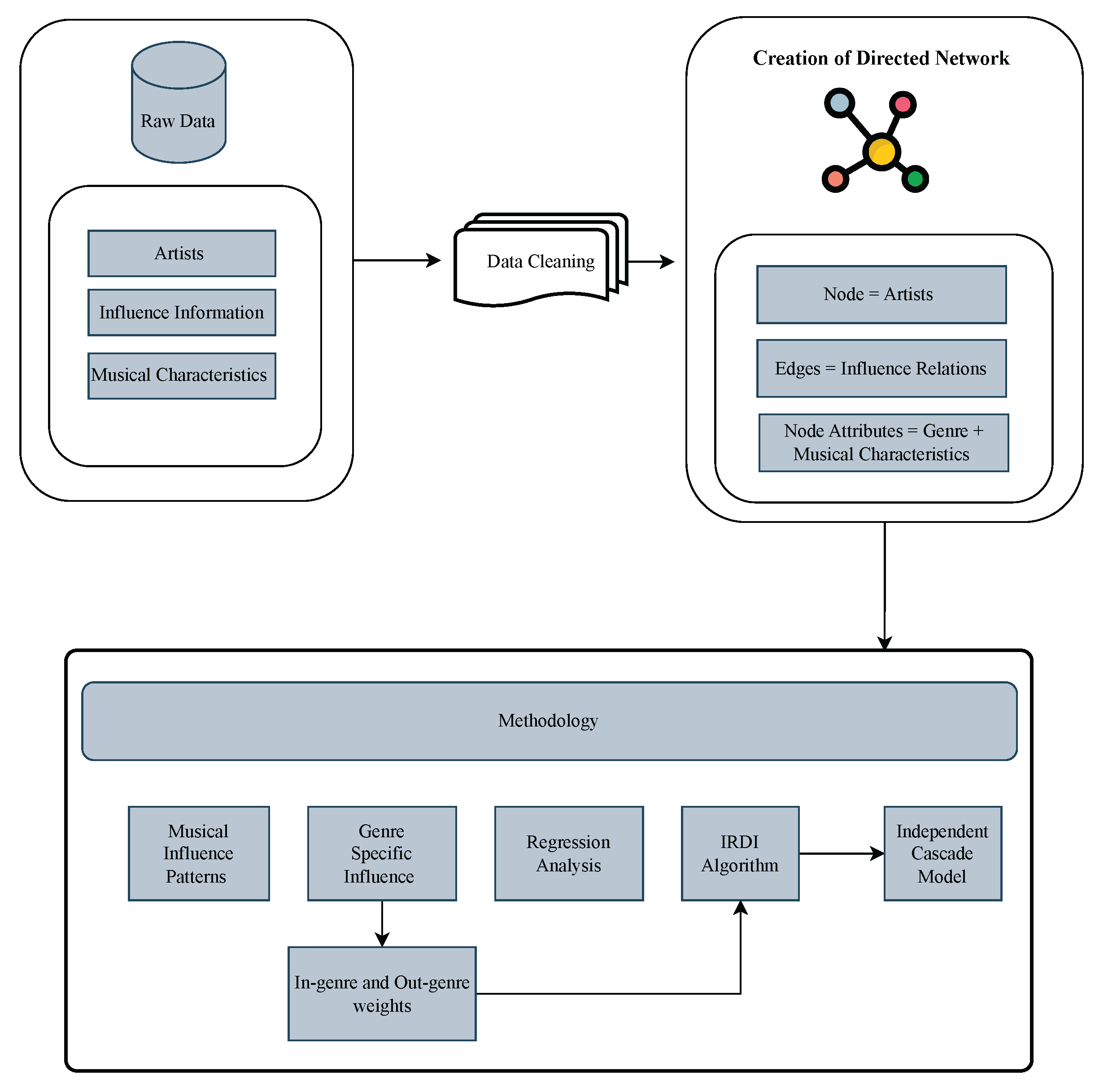

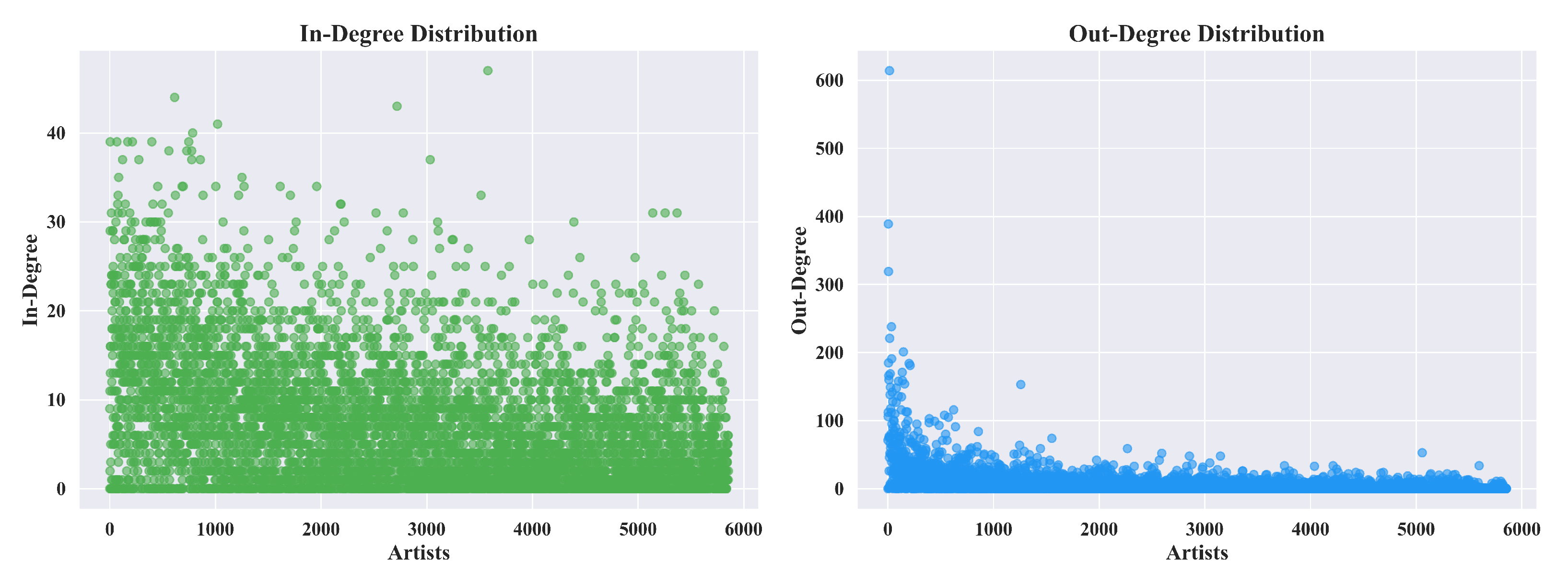
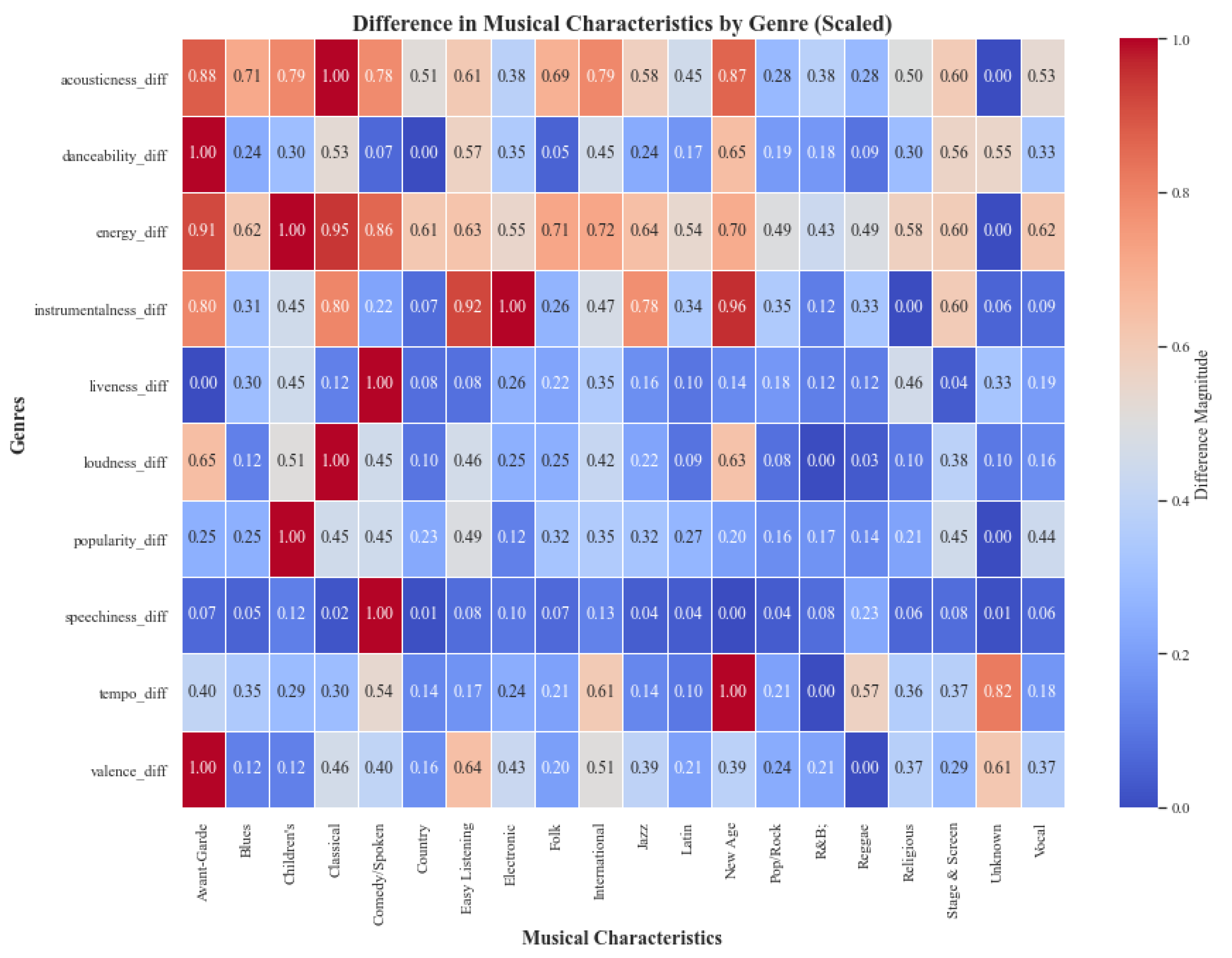
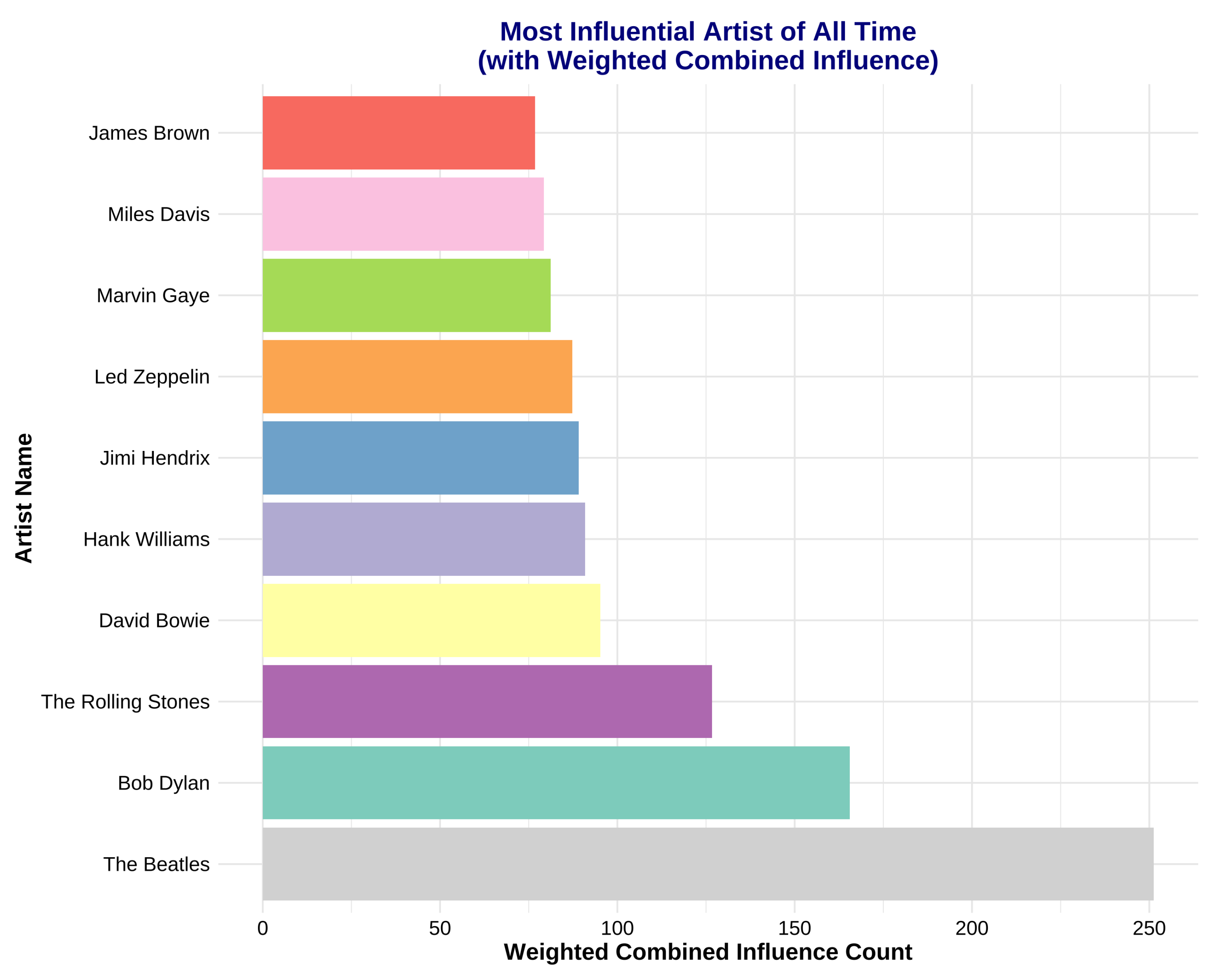
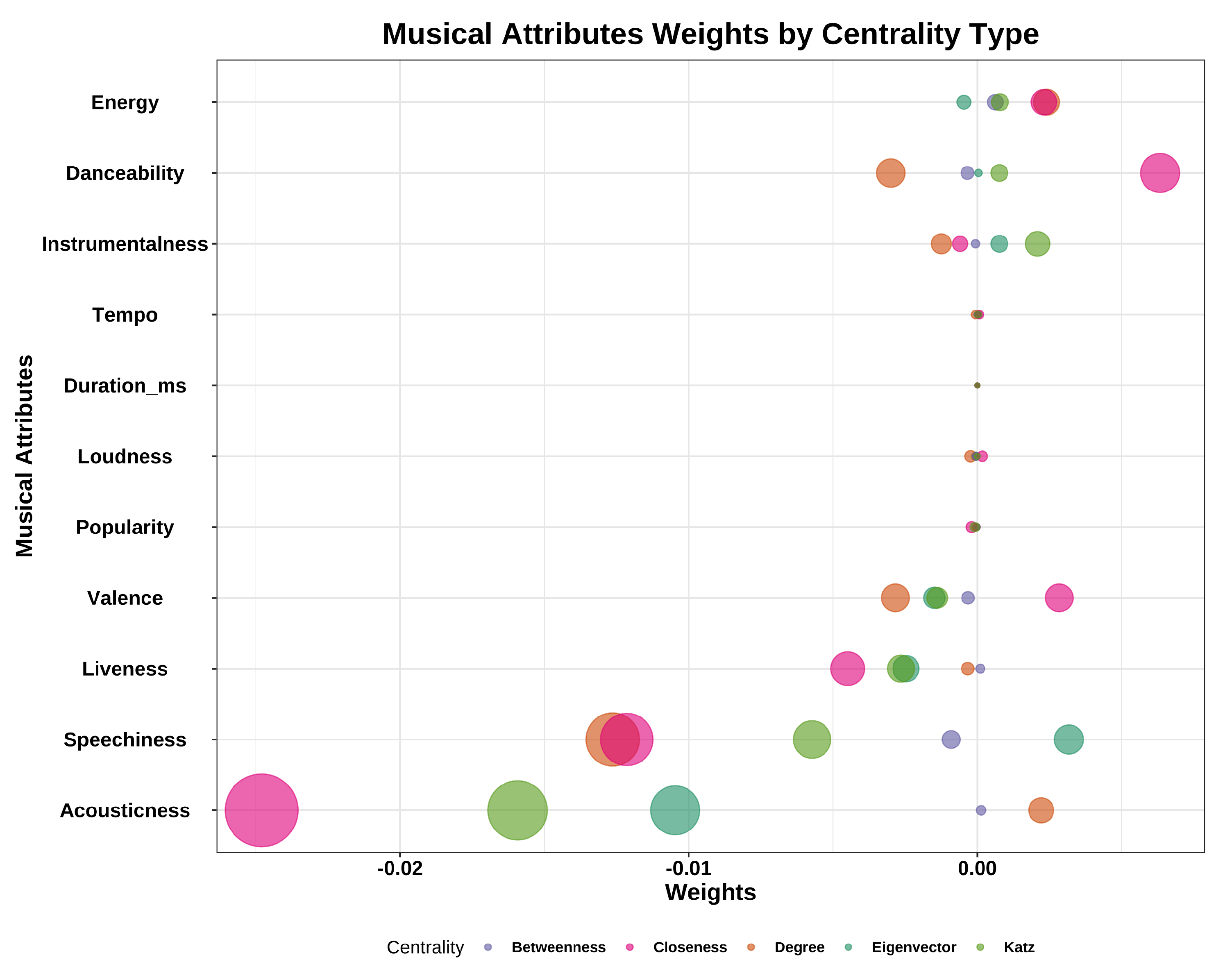
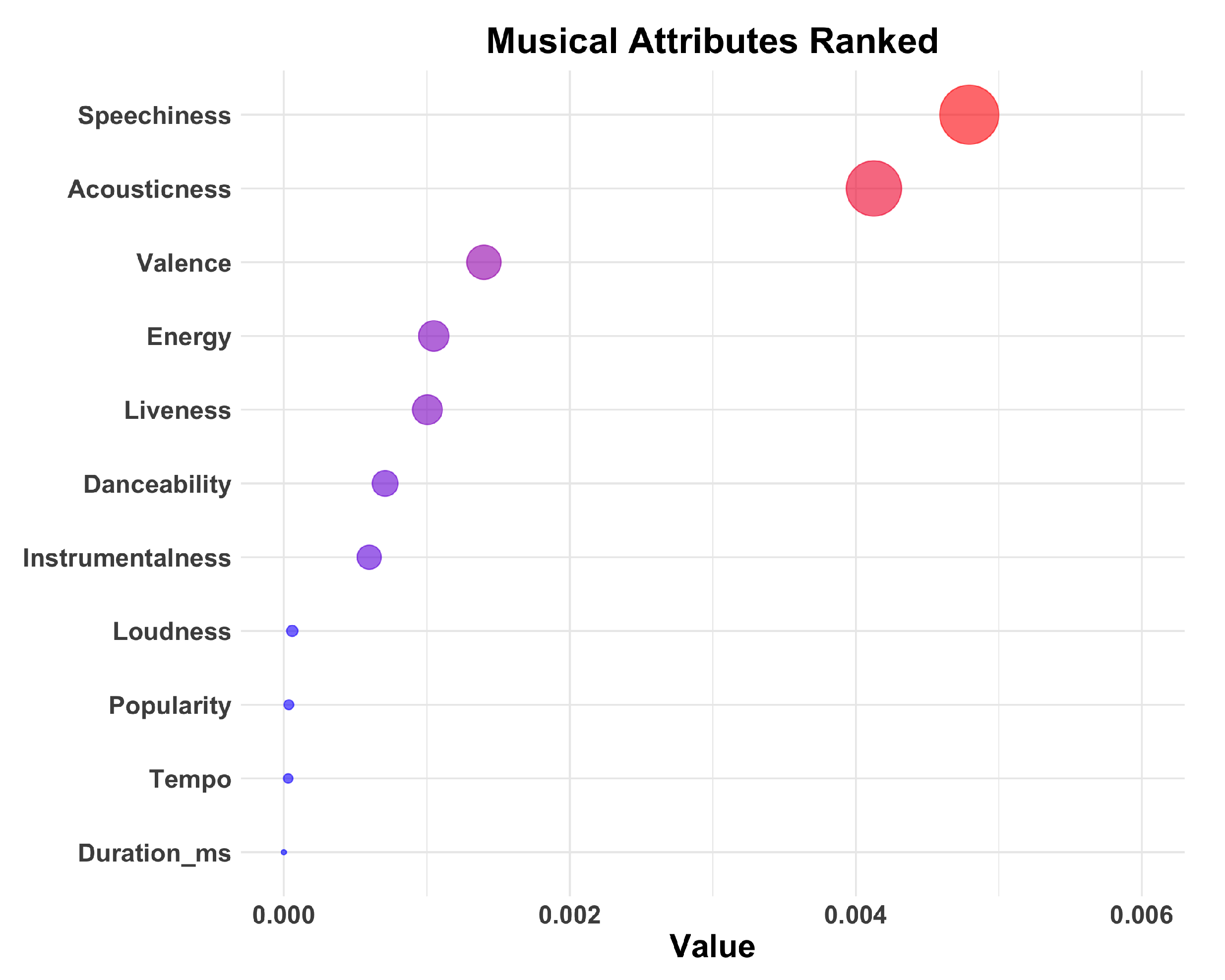
| Symbol | Description |
|---|---|
| G | Graph representing the musical network |
| V | Set of nodes in graph G |
| E | Set of edges in graph G |
| IRDI | Inverse rank-dominant influence |
| IC | Independent cascade |
| Probability of influence propagation from node u to node v | |
| Initial set of seed nodes | |
| Set of active nodes at time t | |
| Set of neighbor nodes that can influence node v | |
| Maximum possible norm difference used for normalization | |
| Number of edges of node i in graph g | |
| Network distance between node i and node j | |
| Number of geodesic paths between nodes j and k passing through node i | |
| Total number of geodesic paths between nodes j and k | |
| Degree centrality of node i | |
| Closeness centrality of node i | |
| Katz–Bonacich centrality of node i | |
| Betweenness centrality of node i | |
| Eigenvector centrality of node i | |
| Proportionality factor used in Eigenvector centrality | |
| Discount factor in Katz–Bonacich centrality | |
| ℓ | Length of walks in the Katz–Bonacich centrality |
| Error term in regression models | |
| MSE | Mean Squared Error, a metric to evaluate the regression model’s performance |
| Regularization parameter in various regressions | |
| Mixing parameter between Ridge and Lasso in ElasticNet regression | |
| Intercept and slope coefficients in regression models | |
| Big O notation, denoting computational upper bounds |
| Measure | Definition | Equation |
|---|---|---|
| Degree | Measures the number of edges of the node i, reflecting its connectivity or “popularity”. | |
| Closeness | Based on the network distance between a node and each other node, extending degree centrality by considering neighborhoods of all radii. | |
| Eigenvector | The prestige of node i is related to the prestige of its neighbors. | |
| Katz–Bonacich | A measure of prestige based on the number of walks from node i. Shorter walks are valued more. | |
| Betweenness | Measures a node’s role as an intermediary in connecting other nodes in the network. |
| Degree Centrality | Closeness Centrality | Betweenness Centrality | Eigenvector Centrality |
|---|---|---|---|
| The Beatles | Jonas Brothers | Willie Nelson | Paramore |
| Bob Dylan | Avril Lavigne | Uncle Tupelo | We the Kings |
| The Rolling Stones | Hilary Duff | Phosphorescent | Disturbed |
| David Bowie | Meghan Trainor | Hoyt Axton | Flyleaf |
| Led Zeppelin | Demi Lovato | The Kingston Trio | Thirty Seconds to Mars |
| Model | Description | Equation |
|---|---|---|
| Linear | Basic linear model. | |
| Ridge | Penalizes the sum of squared coefficients (L2 penalty). | |
| Lasso | Penalizes the sum of absolute values of the coefficients (L1 penalty). | |
| ElasticNet | A convex combination of Ridge and Lasso. | |
| Bayesian Ridge | Linear with Bayesian regularization. | Varies by priors. |
| Characteristics | Most Influential Artist |
|---|---|
| Acousticness | Mastodon |
| Danceability | Zedd |
| Duration (ms) | Caron Wheeler |
| Energy | Bappi Lahiri |
| Instrumentalness | Gavin DeGraw |
| Liveness | Miles Davis Quintet |
| Loudness | Easton Corbin |
| Popularity | Ed Bruce |
| Speechiness | David Foster |
| Tempo | Martin Gore |
| Valance | Freda Payne |
| Musical Characteristics | Absolute Difference |
|---|---|
| Speechiness | 0.028 |
| Liveness | 0.084 |
| Danceability | 0.097 |
| Instrumentalness | 0.124 |
| Energy | 0.149 |
| Valance | 0.150 |
| Acousticness | 0.188 |
| Loudness | 3.109 |
| Popularity | 9.774 |
| Tempo | 14.137 |
| Duration | 58,797.095 |
| Musical Characteristics | Lowest Difference Genre |
|---|---|
| Danceability | Country |
| Energy | Unknown |
| Valence | Reggae |
| Tempo | R&B |
| Loudness | R&B |
| Acousticness | Unknown |
| Instrumentalness | Religious |
| Liveness | Avant-garde |
| Speechiness | New age |
| Duration | Unknown |
| Popularity | Unknown |
| Artist | In-Genre | Out-Genre |
|---|---|---|
| Hank Williams | 97 | 87 |
| Muddy Waters | 33 | 80 |
| Miles Davis | 83 | 77 |
| Kraftwerk | 31 | 77 |
| James Brown | 78 | 76 |
| Howlin’ Wolf | 25 | 74 |
| Billie Holiday | 34 | 72 |
| Marvin Gaye | 99 | 70 |
| Ray Charles | 44 | 69 |
| Bob Dylan | 322 | 67 |
| Artist | In-Genre | Out-Genre |
|---|---|---|
| The Beatles | 553 | 61 |
| Bob Dylan | 322 | 67 |
| The Rolling Stones | 304 | 15 |
| David Bowie | 224 | 14 |
| Led Zeppelin | 213 | 8 |
| The Kinks | 191 | 0 |
| The Beach Boys | 179 | 6 |
| The Velvet Underground | 175 | 6 |
| Black Sabbath | 169 | 2 |
| The Byrds | 153 | 5 |
| Centrality Measure | In-Genre Weight | Out-Genre Weight |
|---|---|---|
| Eigenvector centrality | 0.39 | 0.61 |
| Betweenness centrality | 0.34 | 0.66 |
| Closeness centrality | 0.56 | 0.44 |
| Degree centrality | 0.56 | 0.44 |
| Katz centrality | 0.35 | 0.65 |
| Eigenvector | Betweenness | Katz | Degree | Closeness |
|---|---|---|---|---|
| The Beatles | The Beatles | The Beatles | The Beatles | The Beatles |
| Bob Dylan | Bob Dylan | Bob Dylan | Bob Dylan | Bob Dylan |
| The Rolling Stones | The Rolling Stones | The Rolling Stones | The Rolling Stones | The Rolling Stones |
| David Bowie | Hank Williams | Hank Williams | David Bowie | David Bowie |
| Hank Williams | David Bowie | David Bowie | Led Zeppelin | Led Zeppelin |
| Jimi Hendrix | Jimi Hendrix | Jimi Hendrix | The Kinks | The Kinks |
| Led Zeppelin | Marvin Gaye | Marvin Gaye | Jimi Hendrix | Jimi Hendrix |
| Marvin Gaye | Miles Davis | Led Zeppelin | The Beach Boys | The Beach Boys |
| Miles Davis | Led Zeppelin | Miles Davis | The Velvet Underground | The Velvet Underground |
| James Brown | James Brown | James Brown | Black Sabbath | Black Sabbath |
| Characteristics | Mean Squared Error | Regression Model |
|---|---|---|
| Eigenvector centrality | 1.10 | Bayesian Ridge regression |
| Degree centrality | 7.82 | Lasso regression |
| Betweenness centrality | 3.79 | Lasso regression |
| Closeness centrality | 3.49 | Lasso regression |
| Katz centrality | 1.17 | Linear regression |
| Seed Set | Average Time to Reach All Nodes (Steps) |
|---|---|
| Degree centrality | 10.88 |
| Closeness centrality | 3.00 |
| Betweenness centrality | 15.24 |
| Eigenvector centrality | 2.00 |
| IRDI algorithm | 10.22 |
| Zhang et al. [6] | 10.52 |
Disclaimer/Publisher’s Note: The statements, opinions and data contained in all publications are solely those of the individual author(s) and contributor(s) and not of MDPI and/or the editor(s). MDPI and/or the editor(s) disclaim responsibility for any injury to people or property resulting from any ideas, methods, instructions or products referred to in the content. |
© 2023 by the authors. Licensee MDPI, Basel, Switzerland. This article is an open access article distributed under the terms and conditions of the Creative Commons Attribution (CC BY) license (https://creativecommons.org/licenses/by/4.0/).
Share and Cite
Lamichhane, B.; Singh, A.K.; Devkota, S.; Dhakal, U.; Singh, S.; Dhakal, C. Understanding the Influence of Genre-Specific Music Using Network Analysis and Machine Learning Algorithms. Big Data Cogn. Comput. 2023, 7, 180. https://doi.org/10.3390/bdcc7040180
Lamichhane B, Singh AK, Devkota S, Dhakal U, Singh S, Dhakal C. Understanding the Influence of Genre-Specific Music Using Network Analysis and Machine Learning Algorithms. Big Data and Cognitive Computing. 2023; 7(4):180. https://doi.org/10.3390/bdcc7040180
Chicago/Turabian StyleLamichhane, Bishal, Aniket Kumar Singh, Suman Devkota, Uttam Dhakal, Subham Singh, and Chandra Dhakal. 2023. "Understanding the Influence of Genre-Specific Music Using Network Analysis and Machine Learning Algorithms" Big Data and Cognitive Computing 7, no. 4: 180. https://doi.org/10.3390/bdcc7040180
APA StyleLamichhane, B., Singh, A. K., Devkota, S., Dhakal, U., Singh, S., & Dhakal, C. (2023). Understanding the Influence of Genre-Specific Music Using Network Analysis and Machine Learning Algorithms. Big Data and Cognitive Computing, 7(4), 180. https://doi.org/10.3390/bdcc7040180









